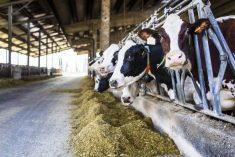Demand for hopper cars to move this year’s record grain crop is unusually high.
However, the number of rail cars being supplied to country elevators is still well below the number that have been requested.
Executives at Canada’s major railway companies say they are working flat out to move Western Canada’s record crop.
Officials at Canadian National Railway said the country’s grain supply network is already operating near full capacity and has been for several weeks.
In an Oct. 22 conference call, CN officials said the company has been spotting 5,300 or 5,400 hopper cars per week since early October.
Read Also

Alberta Crop Report: Rains in the south, dryness in the north
Rain fell onto the southern half of Alberta last week, while hot and dry conditions persisted in the northern half, according to the province’s crop report released on July 18.
It is unusually high from the company’s perspective but well below what grain handling companies are requesting, according to the Western Canadian Grain Elevators Association (WCGEA).
Executives at Canadian Pacific Railway said they are also moving record volumes of grain.
CP is anticipating heavy grain traffic throughout the winter with record volumes to the West Coast and strong eastern movement as well.
“In a non-regulated environment now … customers want to get that product to market, so if you keep their export elevators full, you’re going to be rewarded with business and that’s what we’re seeing,” said CP president Keith Creel.
“If we’ve got the assets, the cars available and we’re making the turns at the West Coast where most of that grain is going, we’re going to be in play.”
Grain car availability will be top of mind for the Canadian grain industry this winter as it attempts to market a record Canadian crop estimated at 68 million tonnes.
Last week, Wade Sobkowich of the WCGEA said grain companies are already rationing sales to match rail capacity.
Unused storage capacity in Western Canada’s country elevator system is estimated at less then 10 percent, he added.
In an Oct. 23 newsletter to producers, CWB pool manager David Przednowek said requests for rail cars jumped quickly after a slow start to the harvest.
Railways have responded well, but demand for cars is extremely high, he added.
“Any time that the railways can spot over 5,000 empties in the country in a given week, is a really good week for them, and they’ve both been able to consistently do that,” Przednowek said.
“The issue is not the performance of the railways so far, it’s the fact that … open order books are maybe double that size, so the shortfall on both railways is growing.”
CN president Claude Mongeau said satisfying customer demand for grain cars could be difficult this winter, especially if weather becomes a limiting factor.
“It’s definitely a big challenge,” Mongeau said.
“There’s a record crop out there and we’ve really got to step it up to put all the pieces of the supply chain in sync to be able to keep our spotting well above 5,000 every week.”
A recent CN derailment at Gainford, Alta., west of Edmonton has complicated efforts, at least temporarily.
The company’s main line through Alberta was closed for nearly four days last week after 13 cars in a mixed freight train jumped the rails, prompting the evacuation of nearly 100 residents.
The line was reopened late Oct. 22 but restoring fluid train movements will take time.
“With the residents of Gainford now safely back at home, our focus is on recovering a fluid network,” Mongeau said.
“We have a lot of work to do to catch up in terms of traffic.”
The railway is optimistic that it will conclude a new labour agreement with roughly 3,000 CN employees, including conductors and yard workers, who have been without a contract since late July, Mongeau added.
“The discussions are ongoing and I’m hopeful that we will be able to reach a win-win agreement in the next few days,” he said.
Jim Vena, chief operating officer at CN, said mild weather and network co-ordination will be critical to maintaining grain movement through the winter.
“We’ve got to make sure we’ve got the right plan at origin, working closely with the elevators so that they’re ready for us and we’re not wasting car time … load time and locomotive time,” Vena said.
“We also have to make sure we understand the flow of ships coming in, what they can take out and make sure that that all works together. If we can get all of that in the mix, we should be able to maintain (car spots) well over 5,000 from now moving forward.”
Improvements to CN’s fleet of locomotives and a $100 investment in rail infrastructure on the company’s main line between Winnipeg and Edmonton will help maintain flows on the Prairies.
“We’re as ready as we can be,” Vena said.
CP is also optimistic that it will continue to move record grain volumes, Creel said.
“We’ve responded to the record Canadian grain demand, moving from a near dead stop through August due to the late harvest to transporting record volumes by the month end,” he said.
“In fact, we moved 12 percent more grain loads (in the third quarter of 2013) than in 2012. This obviously sets us up extremely well for the big crop ahead of us.”
















